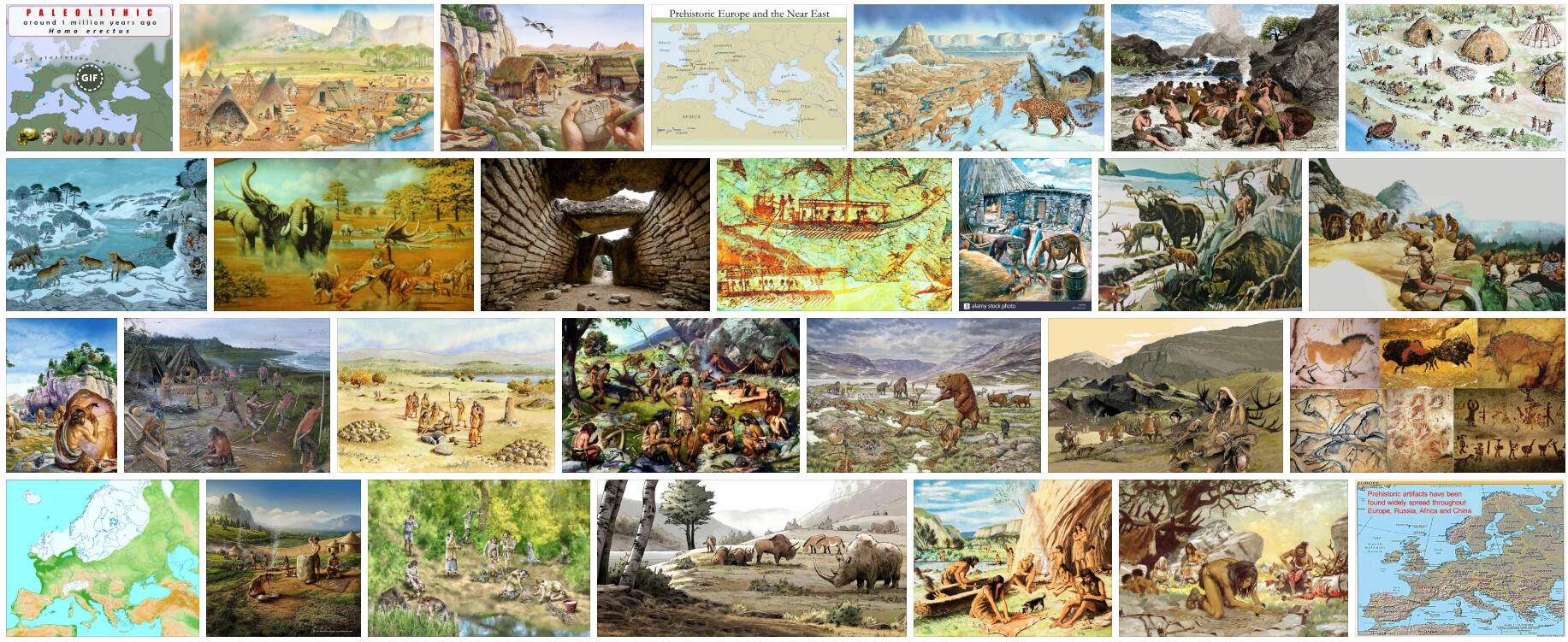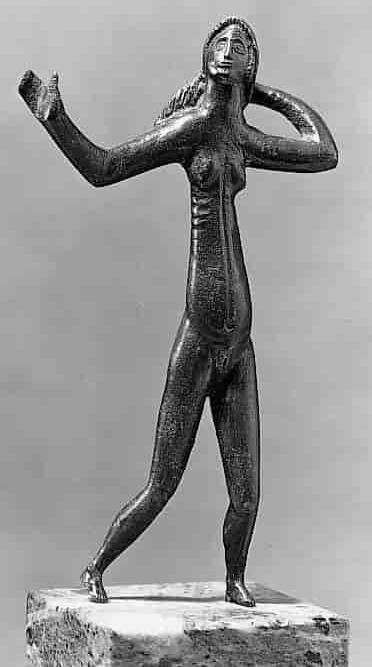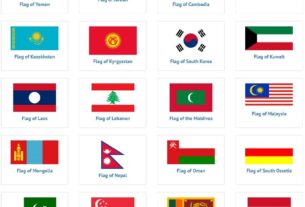The man came to Europe for between 1 and 3/4 million years ago, probably from Africa, where the early human type Homo erectus lived from 1.6 million years ago. Europe is the large area of land that is between Asia and the Atlantic Ocean.
Paleolithic
Hunting of the great game of the forest and the steppes, forest elephant, mammoth, bison, aurochs and rhinos, formed the basis of life in the older Paleolithic. The oldest tools, pebble-tools, have been found at Vallonnet in France and in Isernia in Italy. From for approximately 1/2 million years ago, finds with hand wedges are known, and from the same time the oldest human find originates, the lower jaw from Mauer near Heidelberg. It may have belonged to H. erectus, while the somewhat later human remains from Arago in France, the Sierra de Atapuerca in Spain, Steinheim and Bilzingsleben in Germany are attributed to the pre-Neanderthal or archaic Homo sapiens.
In the Middle Paleolithic, the moustéria, 200,000-35,000 years ago lived the Neanderthal man, who in addition to more developed stone tools has left behind the oldest known burials in Europe. However, the Neanderthals disappeared 40,000-35,000 years ago when the modern human type, Homo sapiens sapiens, which was already widespread in Asia and Africa, immigrated and brought the culture aurignacia to the southern parts of the continent. Thus began the younger Paleolithic, during which the hunter-gatherer population developed a finer tool technology and an adaptability that made it possible to withstand the extreme climatic conditions during the last ice age. Among other things, expressed through a specialization in hunting specific animals such as the mammoth hunters on the river Don and the reindeer hunters in northern Europe. During the Late Paleolithic, great artistic creativity unfolded, known in the form of Venus statues and cave paintings with depictions of a rich animal world (see Altamira, Chauvet Cave). Only after the last ice age cold maximum during the Hamburg culture from approximately 12,500 BC hunter-gatherers found their way to the southernmost parts of Scandinavia.
Europe. This 14 cm high Celtic female figurine of bronze from Neuvy-en-Sullias near Orléans has been found along with other bronze figurines near the Loire River not far from a Celtic sanctuary. The woman who might perform a cultic dance differs somewhat from the otherwise rigid Celtic figure art. This more vivid design shows influences from Greek or Roman art, while the excessively slender and elongated body suggests inspiration from the Etruscans; especially in Volterra, extremely slender figures were produced.
Mesolithic
After the end of the last ice age approximately 9300 BC the forest spread over most of Europe. See Countryaah.com for countries in Europe. A scattered and sparsely populated hunting population settled by streams and lakes, where there were favorable conditions for hunting, fishing and gathering. During the mainland until approximately 7500 BC settlement also took place in areas that are now sea-covered, eg the entire southern part of the North Sea. Well-preserved finds of cabins, utensils and meal waste are known from the Maglemose culture in Denmark. In Atlantic times, approximately 7000-3900 BC, settlement in many places in Western and Northern Europe was concentrated along the coasts, as evidenced by the remains of kitchen manure in Portugal, Brittany, Scotland and Denmark. In northernmost Scandinavia, there were hunting and fishing communities that settled into spacious houses and depicted game on the rocky surfaces, see Alta.
Neolithic
While much of the continent was still inhabited by hunters, fishermen and gatherers, agriculture and livestock farming spread 7000-4000 BC. gradually from Southeastern to Western Europe and Southern Scandinavia. The early peasant culture in Greece and the Balkans is considered to have immigrated from already cultivated areas in Asia Minor. Well-organized village communities grew over time to tell ‘is’ urban high’, as in the Middle East. Sailing in the Mediterranean must already at that time have contributed to the further spread of Neolithic occupations, which, however, in most places in Southern Europe developed by a gradual change.
To Central Europe, agriculture spread from about 5400 BC. with the ribbon-ceramic culture that quickly established villages with timber-built longhouses in a belt from the Paris Basin to Moldova. The ribbon ceramics’ very uniform cultural pattern was approximately 5000-3500 BC replaced by societies with very different structures. In Ukraine there were large fenced villages as in the Balkans; at the foot of the Alps, seafront settlements, pile buildings were built, while the settlements in northern Europe were divided into many small units. Here and in Western Europe, the early peasant communities were characterized by special ritual facilities, partly monumental tombs in the form of long, later megalithic tombs, partly large gathering places that were surrounded by fences and ditches. Megalithic tombs were built in western France as early as 4500-4000 BC, in Scandinavia only after 3500 BC. The construction of burial chambers on the Iberian Peninsula, in Ireland and in southern Scandinavia took place at about the same time, 3200-3000 BC. Other megalithic monuments are known from the British Isles, from Brittany in the form of avenues of monumental stone and from Malta in the form of stone temples. In Britain there are many stone circles; the most famous is Stonehenge, which first got its final design in the early Bronze Age.
Copper production began in Eastern Europe and the Balkans already approximately 4500 BC, and the time until this metal was replaced by bronze, which is an alloy of copper and tin, is called the Copper Age. Graves at Varna in Bulgaria from approximately 4000 BC contains a wealth of copper weapons and gold jewelry. Metal-rich areas of Europe came under the control of an armed elite who had castles built such as Dimini in Greece and Los Millares in Spain.
After 3000 BC. most of northern, central and eastern Europe came under the influence of societies characterized by individual burials, armament with battle axes and great mobility, which is underlined by chariot finds and the use of domestic horses north of the Black Sea. For many of these communities, the term string ceramic cultures is used, alluding to string ornaments on a standardized beverage service. A similar phenomenon occurred approximately 2500-2000 BC in Western and Central Europe with the bell-cup culture that in many places marked the breakthrough for the use of metals.
Bronze Age
The string potters were Neolithic peasants and cattle breeders who must have lived a more independent life than the people of the Aegean area, where palaces such as Troy arose at the same time in the early Bronze Age. The development here led to approximately 2000 BC to the creation of a palace culture on the basis of an economy that included the cultivation of wine and olives as well as trade, shipping and conquests. In Central Europe, the Bronze Age began approximately 2000 BC with the appearance of an elite marked by princely burials within the Aunjetitz culture, which coincided with the Wessex culture in the South of England. In the Nordic countries, significant amounts of metal were imported, and a rich Bronze Age culture came to unfold, especially from approximately 1500 BC Its art and symbolic language, known from the rock carvings and sculptures in the Kivik tomb in Sweden with depictions of tanks and ships, have parallels in the shaft tombs in Mycenae, Greece. 1200-1100 BC the palaces in the Aegean and Asia Minor were overrun by strangers. At the same time, with the Urnemark cultures in Central Europe, a new pattern of society emerged, burial customs changed to cremation, and new types of swords were introduced, while knowledge of iron production spread.
Iron Age
The iron was used in Greece approximately 1000 BC From approximately 800 the Greek maritime trade began to expand, and with the establishment of colonies in Italy from the mid-700-t. the Greeks gained trade contact with the iron-producing Etruscans. From approximately 600 connected to Scythians and Thracians by the Black Sea. With the Hallstatt culture in the Alpine region and eastern Central Europe, approximately 700 a military elite who amassed significant wealth behind solid castle walls. From the same area, princely tombs with rich equipment are known, which include carts, metal vessels, imported Greek luxury goods and wine. In Eastern Europe, the Hallstatt period was characterized by the construction of castles on ridges, and fortified cities arose, such as at Biskupin in Poland.
While the Mediterranean in the last 500 years BC. entered the light of history, the prehistoric Iron Age continued in the rest of Europe. In the La Tène period from 500 BC. Celtic culture left its mark on large parts of Europe from Ireland to the Black Sea. In a core area between the Loire River and the middle Danube, a civilization emerged with large fortified cities, oppida, where production and trade were highly developed and included coinage. The art of the Celts united many foreign features (see the Gundestrup boiler). A particular Celtic style was preserved in Ireland and Scotland well into Christian times.
After the birth of Christ, most of Europe was under the influence of the Romans, whose weapons and merchandise spread beyond the Roman border, glued, not least to the Germanic tribes of northern Europe. When the Romans lost control after the division of the empire in 395, the wars and dukes of the migration period set in and culminated in the Huns’ attacks until 453. While the migrations continued with the invasion of anglers and Saxons in Britain until approximately 500, new kingdoms took place in Central and Southern Europe; the most significant of these was the Merovingian Empire from 481. The time after the fall of the Roman Empire approximately 400 is considered the Middle Ages in most of Europe; however, the Iron Age in Northern Europe lasted through the Germanic Iron Age (400-750) and Viking Age (750-1050).The Slavs, who were on the rise in Eastern Europe and in the Balkans 500-800, constituted the last great prehistoric people in Europe. Like the Scandinavians, they became Christians late, in some areas only after 1200.
The adaptation to the different natural conditions and business opportunities led to the formation of a mosaic of diverse cultures in Europe through prehistoric times. Yet it is characteristic that the innovations that occurred from the Old Stone Age to historical times in technology, food production and social structure, broke through at the same pace over large areas. In the Mediterranean and South-Eastern Europe, the origins of many cultural changes are seen, but the time shift in relation to the rest of Europe is manageable.



